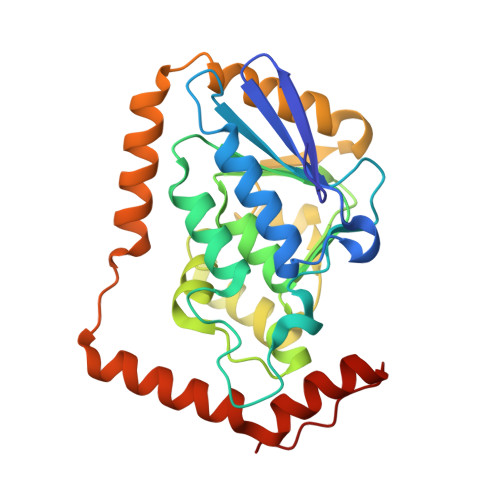Sulfonate/Nitro Bearing Methylmalonyl-Thioester Isosteres Applied to Methylmalonyl-CoA Decarboxylase Structure-Function Studies.
Stunkard, L.M., Dixon, A.D., Huth, T.J., Lohman, J.R.(2019) J Am Chem Soc 141: 5121-5124
- PubMed: 30869886
- DOI: https://doi.org/10.1021/jacs.9b00650
- Primary Citation of Related Structures:
6N92, 6N93, 6N94, 6N95, 6N96, 6N97 - PubMed Abstract:
Malonyl-thioesters are reactive centers of malonyl-CoA and malonyl- S-acyl carrier protein, essential to fatty acid, polyketide and various specialized metabolite biosynthesis. Enzymes that create or use malonyl-thioesters spontaneously hydrolyze or decarboxylate reactants on the crystallographic time frame preventing determination of structure-function relationships. To address this problem, we have synthesized a panel of methylmalonyl-CoA analogs with the carboxylate represented by a sulfonate or nitro and the thioester retained or represented by an ester or amide. Structures of Escherichia coli methylmalonyl-CoA decarboxylase in complex with our analogs affords insight into substrate binding and the catalytic mechanism. Counterintuitively, the negatively charged sulfonate and nitronate functional groups of our analogs bind in an active site hydrophobic pocket. Upon decarboxylation the enolate intermediate is protonated by a histidine preventing CO 2 -enolate recombination, yielding propionyl-CoA. Activity assays support a histidine catalytic acid and reveal the enzyme displays significant hydrolysis activity. Our structures also provide insight into this hydrolysis activity. Our analogs inhibit decarboxylation/hydrolysis activity with low micromolar K i values. This study sets precedents for using malonyl-CoA analogs with carboxyate isosteres to study the complicated structure-function relationships of acyl-CoA carboxylases, trans-carboxytransferases, malonyltransferases and β-ketoacylsynthases.
- Department of Biochemistry , Purdue University , West Lafayette , Indiana 47907 , United States.
Organizational Affiliation:























